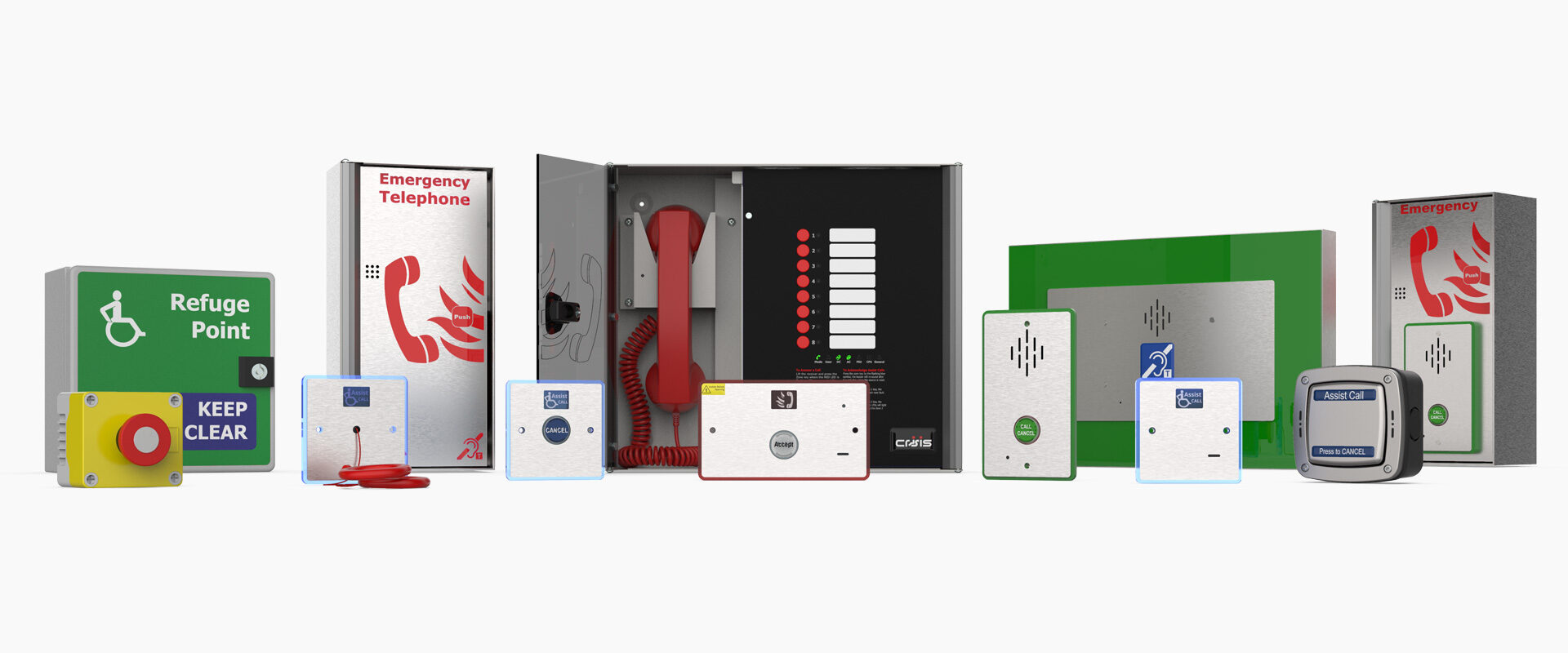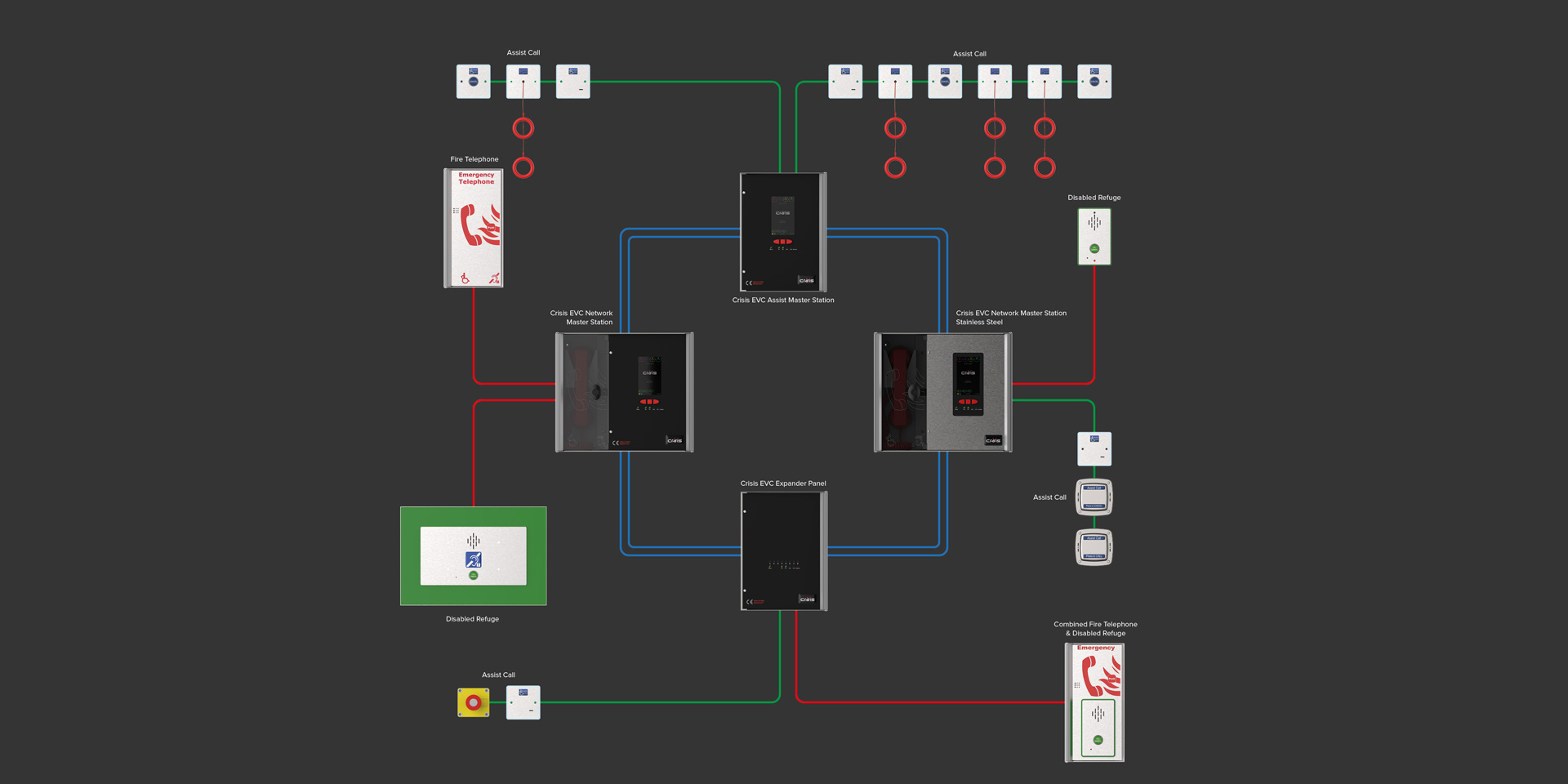Overview
An Emergency Voice Communication (EVC) system provides two-way communication between the emergency services and people inside a building who need assistance with evacuation.
EVC systems are fixed, monitored and maintained, bidirectional, full-duplex communications systems. They allow voice communication in either direction between a central location point and a number of points known as “outstations” located around the building or building complex.
An EVC system is designed specifically to assist in the orderly evacuation of disabled or mobility-impaired people, including injured or pregnant, and increase communication during emergencies. An EVC system can also aid communication for those that are in a building that requires a phased evacuation.
EVC systems should be installed in a designated safe refuge area where, in the event of a fire, those in need of assistance can make their way to and use the system to call for help.
Requirements
The design of an Emergency Voice Communication system is governed by British Standards and guidelines and is part of the BS5839 standard series that provides recommendations for the planning, design, installation, commissioning and maintenance of EVC systems in and around buildings and at sports, entertainment and similar venues.
This standard dictates that the master station should have: a telephone style handset or microphone for voice communication purposes; controls for making calls to and, receiving calls from, outstations; and indicators to identify incoming calls and fault and status indicators. Systems should not be dormant at any time and should be readily available.
Emergency Voice Communication System
An EVC system typically includes:
Fire Telephones
Fire telephones are required in buildings over four storeys in most countries. These telephones provide a hardwired, full-duplex communications system with monitoring and battery back up, and are intended for use as a backup to traditional fire service radio systems which can often fail in high rise environments.
Fire telephones should also be installed in buildings where the shape, size or type requires communication between remote locations and a central control point. This is common in sports venues; in this situation, a fire telephone system can assist stewards in controlling evacuation.
Fire telephones are also required in fire-fighting lift lobbies, when these lifts are provided within a building, and can also be used for wardens to call the control point during fire drills and primary evacuation phases before fire and rescue services arrive and assume control.
Placement
In tall buildings with phased evacuation, an internal speech communication system should be provided between a control point and rescue services on every storey.
Outstations should be located at every fire-fighting entrance point, fire escape landing and fire-fighting lobby. The should be easily accessible, in well-lit areas with low background noise, and positioned 1.3 to 1.4 metres above ground.
In sports stations, fire telephones should be no more than 30 metres from a stewards position or other manned areas such as turnstiles and police rooms.
Disabled Refuge
In the UK, disabled refuge systems are required in all non-domestic premises over one storey or where an emergency exit is by stairs. They are also required as per the appropriate regulation and/or fire risk assessment of any given building, particularly where there are disabled people or people who may have difficulty following the evacuation route.
Placement
A disabled refuge should be provided for each stairway and should provide an accessible area for a wheelchair of at least 900mm x 1400mm. The wheelchair should not reduce the width of the escape route.
A disabled refuge is not just for use during a fire, it must be available at all times. These areas should also be clearly labelled with appropriate fire safety signs.
Refuge outstations should also be located in an accessible, well-lit position with low background noise, and mounted between 0.9m and 1.2 m above the ground.
Assist Call
An emergency assist call must be provided at all disabled toilets within non-domestic premises. If the toilet is in a space that is not permanently occupied, remote indication must be provided at a central control or monitoring point.
An emergency assist alarm can only be reset at the location of the call, so the reset point is within the cubical.
The emergency assist alarm should be fully monitored in line with the specification described in BS8300. It has become increasingly common for the disabled toilet to be specified as part of the disabled refuge system and, by integrating it with the Emergency Voice Communication system, all calls relating to disabled communications can be displayed in a single point.
Crisis Introduction
Crisis Emergency Voice Communication systems combine disabled refuge, fire telephone and assist calls on one single network. This provides significant savings over separate systems and delivers an easy-to-install, low-maintenance package.
Crisis EVC

Crisis EVC systems are suitable for installations with one to eight lines. These systems can monitor disabled refuge, fire telephones and emergency assistance alarms as standard. These systems are easy-to-install and do not require any software.
Crisis EVC systems are easy to use, with eight front panel buttons and LED status indicators. Crisis EVC systems can connect to a single repeater station using their built-in network or can form part of a larger system using a Crisis EVC Network system.

Crisis EVC Network

Crisis EVC Network gives full, site-wide control from any master station on the network. It is a fully distributed system that consists of up to 64 panels accommodating sites with up to 512 lines.
There is a complete range of touchscreen master stations, repeater stations and system expander panels available, and all panels have a built-in network with a fully fault tolerant network protocol with dual redundancy.
Crisis EVC Network is compatible with the complete range of Crisis fire telephone, disabled refuge and emergency assistance alarm systems and is compliant to BS5839-9:2011.

Why Choose Eurofyre?
- Complete System Supplier
- Eurofyre manufactures and supplies all aspects of fire detection and associated safety products and can provide expert advice and consultation.
- Demonstration and Training
- We offer demonstrations and expert training on a range of systems, including the Crisis range of EVC systems, in our very own sophisticated training facility.
- After-Sales Support
- Eurofyre offers both on-site and telephone support to assist you in ensuring that your system is fully functional and operating at maximum efficiency. Our after-sales care and support are second-to-none.